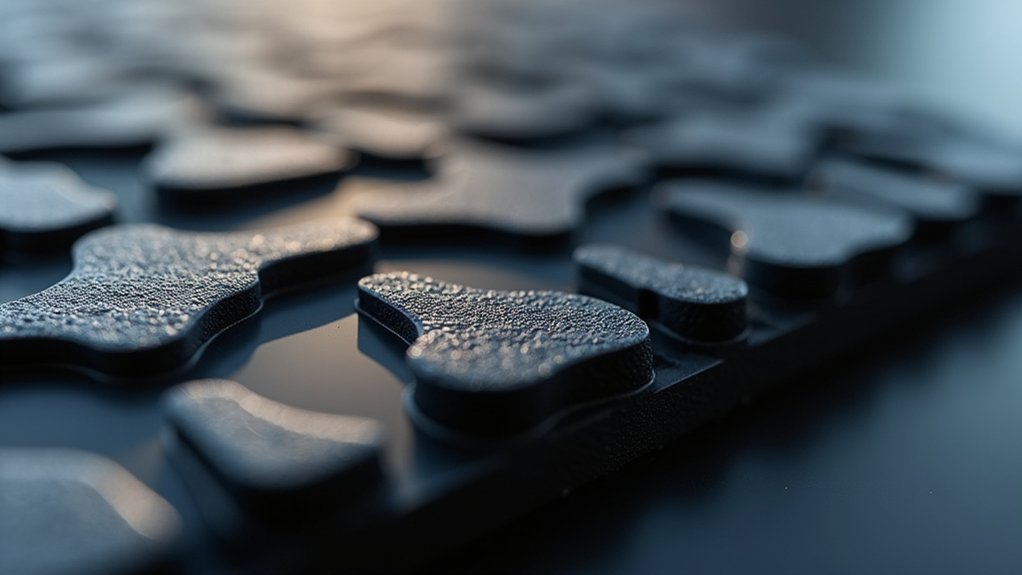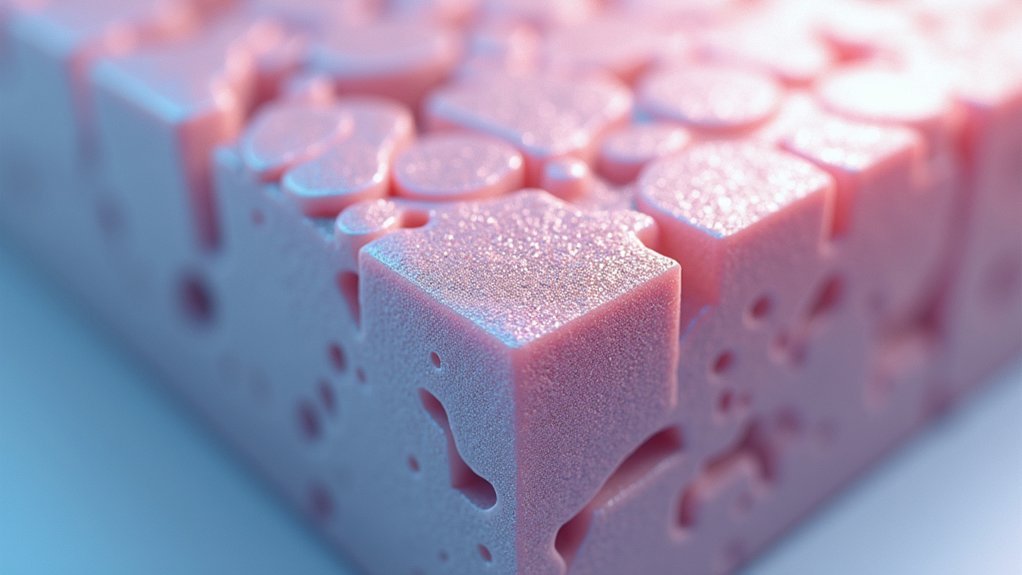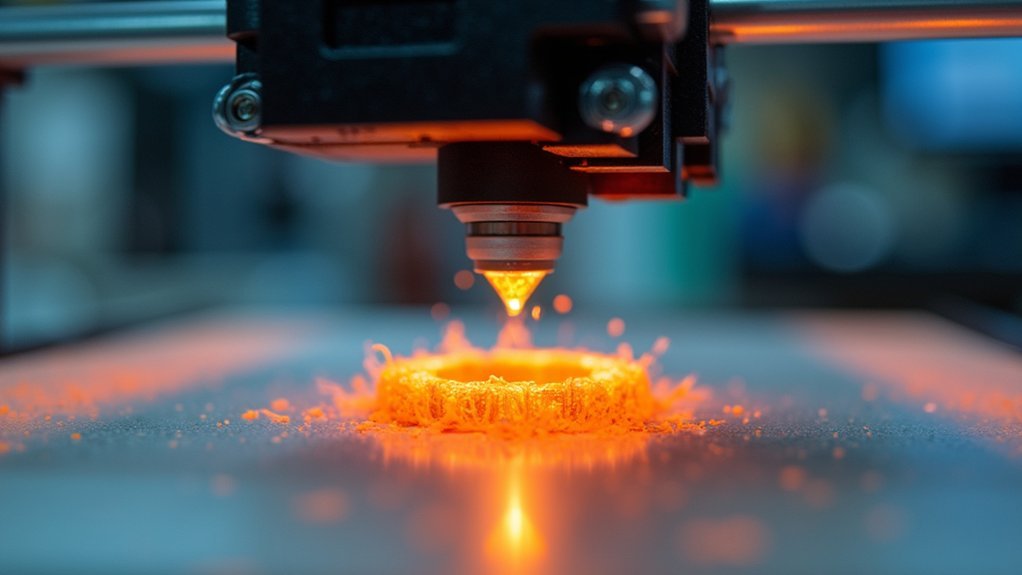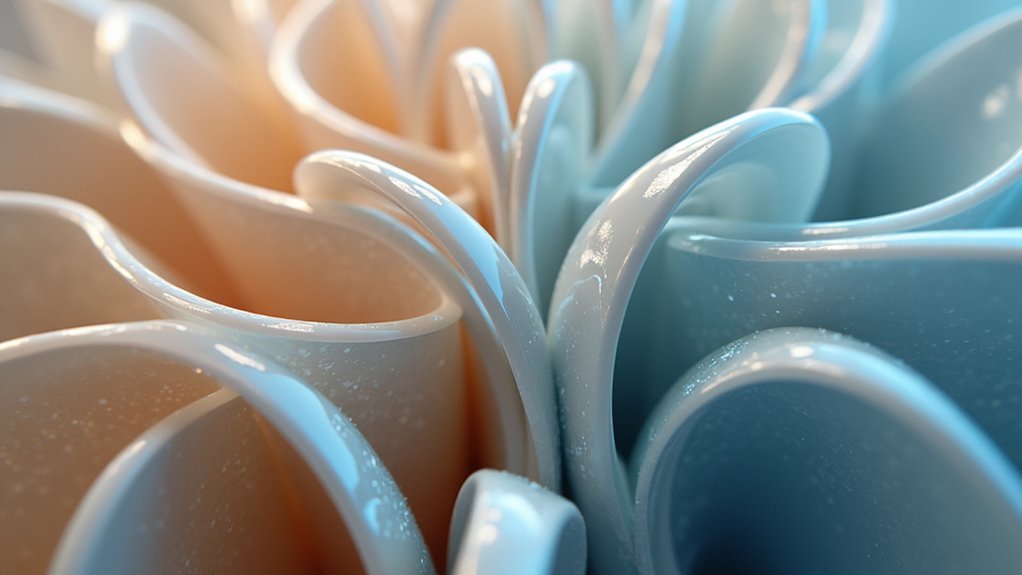TPU-rigid material combinations work because of TPU’s exceptional adhesion properties and ability to form both mechanical and chemical bonds with harder substrates. You’ll get successful results when TPU flows into microscopic surface features of rigid materials like PLA or ABS, creating mechanical interlocking while hydrogen bonding and van der Waals forces provide chemical adhesion. Matching thermal expansion rates and selecting compatible Shore hardness levels prevents delamination and stress fractures for durable multi-material prints with enhanced flexibility and impact resistance.
Understanding TPU Properties in Multi-Material Applications

When you’re designing multi-material applications, TPU’s exceptional elasticity and impact resistance make it the perfect partner for rigid materials, creating products that combine flexibility with structural integrity.
You’ll find TPU’s hardness range of 60A to 80D on the Shore scale bridges the gap between soft, flexible sections and rigid components seamlessly.
The material’s customizable properties give you tremendous control over performance. By adjusting hard-to-soft segment ratios, you can tailor flexibility, tensile strength from 20-100 MPa, and elongation up to 600%.
This versatility means you’re not limited to standard specifications.
TPU’s superior adhesion properties enhance layer bonding with rigid materials, improving overall durability.
You’ll benefit from its wear resistance and shock absorption, making your multi-material applications suitable for demanding automotive, medical, and consumer applications.
Rigid Material Compatibility With Thermoplastic Polyurethane
When you’re combining TPU with rigid materials, you’ll need to understand how molecular adhesion and surface energy differences affect the bond strength between these contrasting substrates.
The printing process becomes notably more complex as you manage different thermal properties, shrinkage rates, and layer adhesion requirements simultaneously.
You’ll face specific challenges with bed adhesion, print speed coordination, and preventing delamination at the interface between flexible and rigid sections.
Material Bonding Mechanisms
Although TPU’s flexibility makes it valuable across countless applications, its true potential emerges when you combine it with rigid materials through strategic bonding mechanisms. You’ll achieve effective adhesion through two primary approaches: mechanical interlocking and surface adhesion.
When working with composite structures, you must consider the chemical compositions of both materials—polyester-based TPUs bond better with nylon due to their similar polar characteristics.
You can enhance interfacial bonding by implementing surface treatments like plasma or chemical etching, which increase surface area for stronger connections.
Managing processing temperatures becomes critical since excessive heat degrades TPU while you need sufficient melting for proper bonding. Understanding Shore hardness of both materials helps you predict your final composite’s mechanical properties and tailor combinations for specific applications.
Multi-Material Printing Challenges
Multi-material printing with TPU and rigid materials presents unique technical hurdles that you’ll need to navigate carefully. TPU’s elasticity creates adhesion challenges when bonding with stiffer filaments, requiring precise temperature control to prevent warping between materials with different thermal properties. You’ll face moisture absorption issues since TPU is hygroscopic, demanding proper storage for both materials.
| Challenge | Impact | Solution |
|---|---|---|
| TPU’s elasticity vs rigid materials | Poor layer bonding, delamination | Optimize adhesion methods, specialized build surfaces |
| Thermal property differences | Warping, inconsistent bonding | Precise temperature control between materials |
| Material interchange issues | Clogging, under-extrusion | Adjust retraction settings and print speeds |
| Moisture sensitivity | Degraded print quality, weak bonds | Proper filament storage, drying protocols |
Adhesion Mechanisms Between TPU and Rigid Substrates

Because TPU exhibits thermoplastic elastomer properties, it forms bonds with rigid substrates through multiple complementary mechanisms that work together to create durable assemblies.
You’ll find that mechanical interlocking serves as the primary adhesion method, allowing TPU’s softer nature to flow into microscopic surface features of rigid substrates. Chemical interactions simultaneously enhance this bond through hydrogen bonding and van der Waals forces, creating stronger adhesion strength.
Surface roughness becomes critical in your material selection—increased texture improves mechanical interlocking considerably.
You’ll achieve better compatibility by matching polarities between TPU and your rigid material, which strengthens chemical bonding. Proper surface preparation, including thorough cleaning and controlled roughening, maximizes these adhesion mechanisms.
Understanding how these factors interact helps you optimize TPU-rigid material combinations for your specific applications.
Temperature Considerations for TPU-Rigid Material Bonding
When bonding TPU with rigid materials, you’ll need to match thermal expansion rates to prevent stress fractures at the interface.
Your print temperatures must be compatible between materials—typically maintaining TPU at 60-80°C while ensuring the rigid substrate reaches appropriate bonding temperature.
You’ll also need to synchronize cooling speeds, as rapid temperature changes can create thermal shock that compromises bond integrity.
Thermal Expansion Rate Matching
Although TPU and rigid materials like ABS or PLA may seem compatible at room temperature, their differing thermal expansion rates can create significant challenges during printing and throughout the part’s service life.
TPU’s coefficient of thermal expansion typically ranges from 50 to 200 x 10^-6/K, while rigid materials hover around 60 to 100 x 10^-6/K. This mismatch can compromise adhesion and durability if you don’t address it properly.
To optimize thermal expansion rate matching in your bonding processes, focus on:
- Select compatible material pairs with similar CTE values to minimize thermal stress at interfaces
- Implement consistent thermal management during printing with controlled heating and cooling cycles
- Conduct thermal cycling tests to validate your TPU-rigid material combinations under real-world temperature variations
Print Temperature Compatibility
While thermal expansion matching sets the foundation for successful TPU-rigid material combinations, achieving proper print temperature compatibility requires careful balancing of each material’s thermal requirements.
You’ll need to select TPU material that bonds effectively with rigid materials like PLA without causing thermal degradation. Since TPU typically prints at 210-250°C and PLA at 180-220°C, finding overlapping temperatures guarantees strong layer adhesion.
You must also balance heated bed settings, targeting 40-60°C for ideal results.
Print speeds become essential—TPU’s slower requirements of 15-30 mm/s help create robust inter-layer bonds.
Don’t overlook your build surface selection, as different materials may need specific surfaces for proper first-layer adhesion and successful multi-material printing.
Cooling Speed Synchronization
Beyond achieving temperature compatibility during printing, you must synchronize cooling speeds between TPU and rigid materials to prevent warping and delamination.
TPU’s lower thermal conductivity requires different cooling rates than rigid materials, creating potential stress concentrations if not managed properly.
Here’s how to optimize cooling speed synchronization:
- Maintain controlled cooling rates – Keep TPU cooling below 5°C/min to preserve elastic properties and guarantee strong adhesion between materials.
- Use a heated bed – Set temperatures between 40-60°C to maintain thermal stability throughout the printing process.
- Adjust fan speeds strategically – Reduce fan speeds after initial layers, allowing TPU to cool gradually while preventing rigid sections from cooling too rapidly.
This synchronized approach guarantees both materials bond effectively without compromising structural integrity.
Shore Hardness Selection for Optimal Material Pairing
When you’re selecting Shore hardness for TPU hardness combinations, you’re making one of the most critical decisions that’ll determine your final product’s performance characteristics.
Your choice directly affects the balance between flexibility and rigidity in your material pairing.
For maximum flexibility, you’ll want softer TPUs ranging from Shore A 70-90, which provide exceptional elasticity for applications requiring significant bend and stretch.
When you need structural integrity, harder TPUs at Shore D 40-60 behave more like rigid plastics while maintaining some give.
Your impact resistance improves dramatically when you match harder TPUs with rigid materials, as they distribute forces more effectively.
Consider environmental conditions like temperature and chemical exposure when making your selection, ensuring your combination maintains durability and performance under operational stresses.
Printer Hardware Requirements for Dual-Material Printing

Since you’ve determined the ideal Shore hardness pairing for your TPU-rigid material combination, you’ll need specialized printer hardware requirements to successfully execute dual-material prints.
Your setup must handle both flexible filaments and rigid materials seamlessly.
Essential hardware components include:
- Dual extruder setup – You’ll need two independent extruders to manage different material properties simultaneously without cross-contamination or feeding issues.
- Direct drive extruder – This prevents TPU buckling and guarantees precise feeding when shifting between materials, eliminating the distance-related problems of Bowden systems.
- Heated bed (60-100°C) – Maintains proper adhesion for both material types throughout the printing process.
Verify compatible filament diameters (typically 1.75mm) and carefully calibrate retraction settings to prevent stringing when switching between materials.
Layer Adhesion Strategies in TPU-Rigid Combinations
You’ll need to master interface temperature control to achieve strong bonds between TPU and rigid materials at their meeting points.
Managing material changeover zones requires precise timing and temperature adjustments as your printer moves between different filament types.
These critical areas determine whether your multi-material print succeeds or fails at the layer boundaries.
Interface Temperature Control
Although TPU and rigid materials have vastly different thermal properties, you can achieve strong layer adhesion by precisely controlling interface temperatures during printing.
Your nozzle temperature must exceed the rigid material’s glass threshold temperature while keeping TPU within its ideal printing temperature range of 210-230°C.
Here’s your interface temperature control strategy:
- Maintain precise nozzle temperatures – Keep temperatures above the rigid material’s glass threshold point while staying within TPU’s sweet spot.
- Set heated bed temperature between 40-60°C – This prevents warping and guarantees proper adhesion between different material layers.
- Reduce print speed for TPU sections – Slower speeds allow better layer fusion and stronger bonds.
A dual-extrusion setup gives you the precise temperature and flow control needed for strong and durable TPU-rigid combinations.
Material Transition Zones
Beyond precise temperature control, the physical zones where TPU meets rigid materials require specific strategies to prevent delamination and mechanical failure.
Material shift zones are critical for achieving effective layer adhesion between contrasting materials. You’ll want to focus on adhesion strength by considering chemical compatibility between your TPU and rigid materials. Surface roughness greatly impacts bonding effectiveness, providing increased contact area for stronger interfacial bonding.
Implement a gradual shift in hardness rather than abrupt changes. Using TPU with Shore 85A adjacent to rigid material with Shore 60D helps mitigate stress concentrations.
Surface treatments and additives on rigid materials can enhance chemical bonding. Optimize your print settings carefully—maintain nozzle temperatures within TPU’s 210-230°C range while protecting rigid material integrity throughout the shift zones.
Print Speed and Flow Rate Optimization
When printing TPU-rigid material combinations, you’ll need to greatly reduce your print speeds to accommodate TPU’s flexible characteristics.
Ideal speeds range from 15-30 mm/s to guarantee proper layer adhesion and prevent warping issues that compromise your print quality.
Your flow rate requires careful adjustment to handle TPU’s elastic nature effectively:
- Set flow rate between 1.05-1.15 to compensate for TPU’s compression and prevent under-extrusion.
- Use direct drive extruders for superior flow rate control and better handling of soft TPU materials.
- Configure minimal retraction settings around 1mm to prevent filament binding during material changes.
These adjustments help manage TPU’s tendency toward stringing and oozing while maintaining compatibility with rigid materials at appropriate extrusion temperatures.
Interface Design Principles for Material Transitions
Since TPU’s elastic properties fundamentally differ from rigid materials’ structural characteristics, you’ll need to design interfaces that accommodate these contrasting behaviors while maintaining strong adhesion.
Effective interface design focuses on compatibility between materials, ensuring seamless material changes without compromising structural integrity.
Material compatibility ensures seamless transitions between components while preserving the structural integrity essential for reliable performance.
You should minimize stress concentrations by creating gradual geometric shifts that distribute forces evenly across the bond line.
Surface preparation plays a critical role—roughening surfaces or applying adhesion promoters greatly improves bonding strength by increasing contact area and promoting chemical adhesion.
Choose flexible adhesives that accommodate TPU’s elasticity while securing rigid components effectively.
Always test your interfaces under dynamic load conditions to verify they’ll withstand operational stresses without delaminating or fracturing during real-world applications.
Thermal Expansion Differences and Warping Prevention
Although TPU and rigid materials bond well when properly designed, their drastically different thermal expansion rates create significant challenges during temperature fluctuations.
You’ll need to address thermal expansion differences proactively to achieve successful warping prevention.
Managing thermal stress requires these essential strategies:
- Temperature Control – Maintain consistent ambient temperature throughout printing and cooling phases while using a heat bed at 40-60°C to improve adhesion.
- Material Selection – Choose TPU with higher Shore hardness to reduce thermal expansion differences and enhance dimensional stability.
- Design Integration – Incorporate fillets and gradual shifts between materials to distribute thermal stress evenly.
These approaches minimize warping by reducing the mechanical stress that occurs when materials expand and contract at different rates during temperature changes.
Support Structure Strategies for Mixed Material Prints
While thermal management addresses one challenge in TPU-rigid material combinations, support structure placement presents equally critical considerations for successful multi-material prints.
You’ll need dual-extrusion capabilities to effectively place support structures using rigid filament beneath flexible TPU sections. Design supports with minimal contact points by adjusting density and patterns, facilitating easier removal process without damaging flexible components.
Consider using soluble support materials like PVA for complex geometries, ensuring clean finishes without manual intervention.
You should reduce infill percentage for TPU segments to enhance flexibility while maintaining structural integrity. Proper calibration of print settings becomes essential when shifting between materials—implement slower speeds and adjusted retraction to prevent stringing or under-extrusion during material changes.
Post-Processing Techniques for Combined Material Objects
Once you’ve completed printing your TPU-rigid material combination, proper post-processing techniques become essential for achieving professional-grade results and ideal functionality.
These methods guarantee seamless integration between your flexible materials and rigid components.
Key post-processing techniques include:
- Surface refinement – Sand rough edges to improve aesthetic finish and create smooth shifts between materials, enhancing overall appearance and feel.
- Bonding enhancement – Apply heat treating with careful temperature control to strengthen adhesion without deforming TPU, or use UV curing with reactive adhesives for durable joints.
- Functional optimization – Machine or trim components for precise fit, then apply specialized coating or painting formulated for both TPU and rigid surfaces to improve visual appeal and performance characteristics.
Real-World Applications and Performance Benefits
With your TPU-rigid combination properly finished and refined, you’re ready to explore the remarkable performance advantages these hybrid materials deliver across diverse industries. TPU’s flexibility makes these combinations exceptionally versatile, offering durability and flexibility that traditional materials can’t match.
| Application | Performance Benefits | Key Advantage |
|---|---|---|
| Smartphone Cases | Impact resistance from drops | Enhanced durability |
| Automotive Parts | Shock absorption capability | Lightweight strength |
| Industrial Gaskets | Chemical exposure resistance | Oil/grease protection |
| Footwear Components | Comfort with structural support | Flexibility retention |
| Aerospace Equipment | Weight reduction maintaining strength | Performance optimization |
These real-world applications demonstrate how TPU-rigid combinations excel where single materials fail, providing enhanced durability while maintaining essential flexibility for demanding environments.
Frequently Asked Questions
How to Make TPU Prints More Rigid?
You can increase TPU print rigidity by using higher infill densities above 50%, selecting harder TPU variants over 90A Shore hardness, adding fiber reinforcements, and incorporating structural ribs into your design.
What Are the Disadvantages of TPU Materials?
You’ll face moisture absorption issues causing bubbles, under-extrusion problems with Bowden extruders, limited post-processing options since it’s solvent-resistant, poor bridging creating strings, and it’s not food-safe for direct contact applications.
What Materials Bond to TPU?
You can bond TPU to metals, plastics, ABS, nylon, PVC, and other elastomers. Surface treatments like plasma or flame treatment improve adhesion, while specialized thermoplastic adhesives enhance durability.
How to Get Better Layer Adhesion With TPU?
You’ll get better TPU layer adhesion by setting your nozzle between 220-250°C, bed at 60-80°C, printing slowly at 15-30mm/s, reducing retraction, and ensuring proper bed leveling.





Leave a Reply